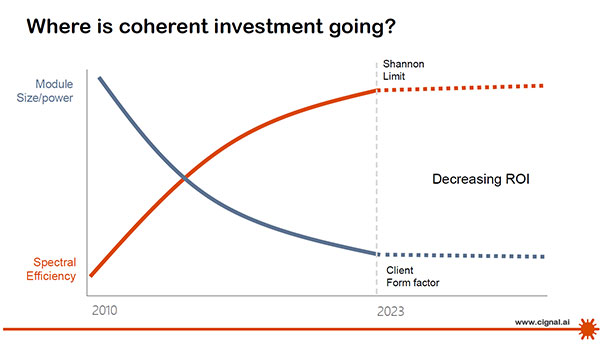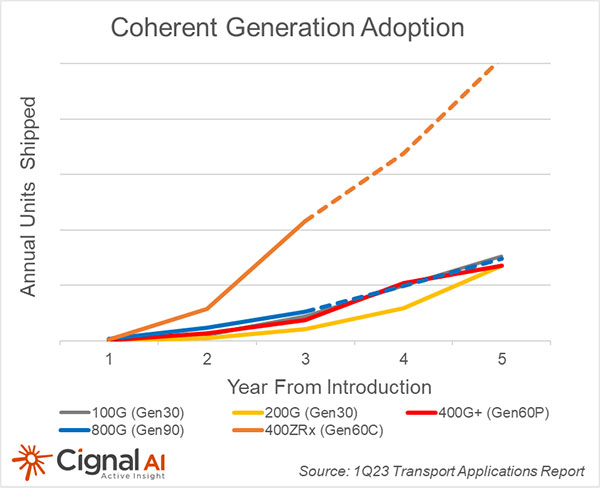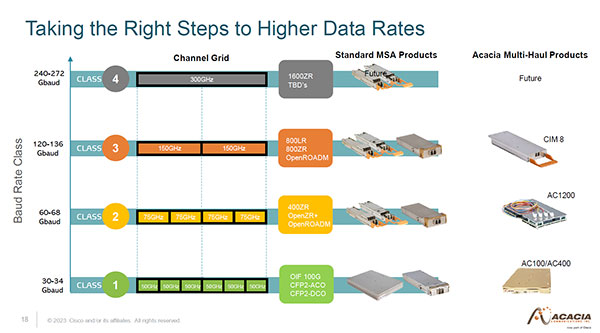With the latest 120+ Gigabaud coherent optics arriving, Cignal AI hosted a webinar featuring speakers from Acacia, Nokia and Verizon to discuss the technology’s cost and performance benefits. Kyle Hollasch, Lead Analyst of Transport Hardware at Cignal AI, kicked off the discussion by highlighting how areas in which we’ve seen significant gains in the past are leveling off. For example, through technologies like high order modulation and probabilistic constellation shaping (PCS), coherent modules are approaching the Shannon Limit where developments yield small increases in spectral efficiency. Meanwhile, size and power have decreased to the point where further gains are unlikely to yield a positive return on investment. However, as he pointed out, “There are now other areas delivering return on investment for coherent module vendors and this revolves around increasing baud rates.” As baud rates have risen from 30 to 60 to 90….and now 120 and above, this has enabled power per bit to continue to decrease significantly, which is proving to be extremely beneficial to operators.

Performance Matters for Verizon as They Plan to Use Both Embedded and Pluggable Optics
Glenn Wellbrock, Director Optical Transport Planning for Verizon, talked about pluggables versus performance optimized (a.k.a. embedded) coherent modules, and how it’s important to leverage the volume that the hyperscalers are using to drive lower cost and power consumption. Glenn commented that the performance of the pluggable modules they’ve tested has exceeded their expectations. While they still plan to use performance optimized optics, they also plan to take advantage of pluggables anywhere they can because of the benefits they can provide in lower cost and power consumption.
Embedded Optics Used Primarily in Ultra Long-Haul Routes Operating Above 400G
On the performance optimized side, Glenn explained how it’s all about getting high performance, which by default usually means higher cost and proprietary implementations. He then went on to describe a field trial that Verizon completed where they were running embedded optics at maximum data rate for metro distances. They tested the same system at lower speeds for a long-haul route from New York to Chicago, demonstrating the benefits of a multi-haul solution. This proved that they could run 400G pretty much anywhere in the country. Glenn also shared that on their long-haul networks, 80% is at or below 1,500km and 600G should be sufficient.
Verizon Plans to Continue Using Performance Optimized Embedded Optics for Ultra Long Haul
In the future, Glenn believes that both performance optimized optics and pluggables will continue to go up in performance. Today, the majority of Verizon’s new Ultra Long Haul (ULH) routes in its network are operating above 400G with embedded optics. According to Glenn, even if the next generation of optics gave Verizon 800G anywhere in the country with great performance, they would still want to know if they could get up to a Terabit or even 1.2T. “If that will work on a lot of Verizon paths in a ULH environment, that is where Verizon is going to gravitate towards and it’s looking like that is going to happen with embedded optics,” added Glenn.
Acacia Sees Trends Influencing How Coherent Interfaces Should Be Developed
Tom Williams, Acacia’s Senior Director of Marketing, highlighted some of the key trends in the industry, starting with coherent moving to shorter reaches. This migration drives higher volumes as well as a need for more standardization because operators want the operational efficiency of interoperability and standards.

Tom recapped how 400ZR/ZR+ has exceeded expectations by being the fastest growing coherent ramp of all time. “We are seeing the core applications that drove the initial OIF 400ZR in the DCI use case and in many of those cases we saw MSA pluggables displacing performance optimized coherent and in others it replaced direct detect,” said Tom. “This has resulted in standardized pluggable optics taking up a higher portion of the coherent market.”
Tom also pointed out that during that same timeframe, the performance of embedded optics has scaled to the point where the industry is approaching the Shannon limit. As a result, component makers are now only seeing incremental improvements in spectral efficiency and operators are not getting significant improvement in capacity on the fiber. That has created a critical need to move to higher baud rates and higher data rates because they provide better economics and better power efficiency from optics. The most efficient way to do this is to develop high performance solutions that align with the investment that is already taking place in the shorter reaches in the pluggable space.
To illustrate the importance of taking the right steps with coherent development, Tom then described the path Acacia has taken. At each class, the company has developed both MSA pluggables and performance optimized solutions. Tom emphasized that, “The benefit that Acacia gets is that we make a big investment in each of these nodes, and we’ve been able to double the baud rate each time. We’ve seen the standards doing this and we’ve aligned our performance optimized solution with those standardized efforts.” As an example, Acacia took the proven optics from the AC1200 operating at 70Gbaud and brought them into the company’s 400ZR/ZR+ products. Using the same platform allowed Acacia to then focus on advancing its packaging technology to take advantage of the efficiencies and have a scalable approach. And today, that same packaging technology is now feeding into the Coherent Interconnect Module (CIM) 8 module, which is enabling a pluggable performance optimized solution operating at 140Gbaud. It’s expected that the next generation will also have a doubling of the baud rates (as shown below) which would adhere to where the standards are expected to align.

As Tom explained, the reason advancements in packaging have been so important is because the high-speed electrical interconnects are often the problem in the RF path when you start going to higher baud rates. By eliminating most of those interconnects, Acacia has been able to significantly extend the bandwidth of the RF chain and still get all the benefits of silicon and standards CMOS processes. Based on the Jannu DSP, the CIM 8 started shipping at the end of 2022 and has already been used in field trials with NYSERNet, China Mobile and Windstream Wholesale.
Nokia Looks to Lower Cost Per Bit with New Techniques
Serge Melle, Director Optical Product Marketing at Nokia, focused on what performance optimized solutions provide from a network applications standpoint. This started with a look at the trends that Nokia sees, and which are driving the key requirements for operators, which include bandwidth growth, faster internet speeds from IP routing platforms, and the need to lower network power consumption to achieve sustainability objectives.
As Serge stated, “This is really where this new generation of 5nm, 120Gbaud+ technology can address all of these things at the same time with the same technology evolution.” By being able to go to 1.2T wavelengths, operators can leverage the technology to achieve 2.4T in a single line card. That enables network operators to get much more scale in deployment of the bandwidth and reduce total cost of ownership, while also providing an effective means of transporting high speed services such as 400 Gigabit Ethernet and 800 Gigabit Ethernet. In addition, the performance improvement of this new generation of technology enables operators to triple the reach at 800G speeds – thereby going from several hundreds of kilometers to 2,000km distances at 800G per wavelengths. Added Serge, “This is a very effective way to transport high-speed services across all network applications and can drive a significant reduction in the number of coherent optics needed in the network, which in turns leads to cost savings. This technology can also provide significant network power savings because it can lower network power consumption by up to 60 percent.”
Like the prior speakers, Serge also stressed the importance of driving down the power per bit. “Every coherent generation has been able to achieve that and this latest generation of 1.2T technology continues the trend by leveraging 5nm silicon, silicon photonics and closer integration,” he said.
Finally, Serge shared how this latest generation of technology can be leveraged across a broad range of applications including metro DCI, long-haul and subsea networks.
Watch the replay
Click here to watch the replay. If you have any questions, please feel free to reach out to us via this contact form.


